Today, with rising sales and shorter product life cycles, obsolete consumer products are abandoned at a swift pace leading to the terrifying number of e-wastes, which often contain toxic elements, such as heavy metals, unsustainable plastics, and flame retardants,. These e-wastes in landfills, oceans, and incinerators not only contribute to global warming but also pose threats to wildlife survival and human health. In 2019, the world generated 53.6 million tonnes of e-waste, severely impacting our ecosystem. By 2030, the global total is expected to increase to 74.7 million tonnes with the new technologies constantly replacing old ones. In Singapore alone, we generate about 60,000 tonnes of e-waste a year, which is equivalent to throwing out about 70 mobile phones per person.
Tan Yu Jun, an Assistant Professor at the National University of Singapore, hopes to reduce the adverse effects brought about by the new development of electronics. So she focuses on developing green materials and manufacturing for emerging technologies, mainly for environmental conservation.
The greatest contribution Tan has made thus far is achieving a breakthrough in stretchable light-emitting capacitors. This work was published in Nature Materials as the first author. In this exciting publication, she developed a new and unique fluoropolymer composite that has very high dielectric permittivity with good elastic properties. This highly transparent material resulted in her group’s demonstration of the highest light output per unit electric field applied among all previous stretchable light-emitting capacitor devices in literature when used as the dielectric material in the light-emitting capacitor device. There were many challenges in materials development and processing to obtain a stretchable material that also has very high dielectric permittivity properties across a large electronic frequency spectrum. When compared to typical silicones, this elastomeric material achieved as high as 5 times more dielectric permittivity at frequencies between 1Hz – 1kHz. This material is the first of its type to be used in light-emitting capacitors and shows great promise to develop new optoelectronic applications in soft machines. She is also a named inventor on the patent application.
She further discovered that the material was able to self-heal autonomously from mechanical damage, and elucidated the mechanism of healing action. Her contributions to this work were exemplary and she showed strong independence in designing and executing several key experiments to further understand the electrical and mechanical properties. She also demonstrated possible applications of such devices in emerging soft robotics applications.
In addition to this work, Dr. Tan was also involved in developing the first underwater self-healable conductive ionogel as the co-first author of a paper published in Nature Electronics. She was deeply involved in characterizing the material and understanding its electromechanical properties.




